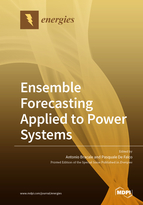Ensemble Forecasting Applied to Power Systems
A special issue of Energies (ISSN 1996-1073). This special issue belongs to the section "F: Electrical Engineering".
Deadline for manuscript submissions: closed (30 September 2019) | Viewed by 25029
Special Issue Editors
Interests: electrical power systems; electric vehicles; optimization models; data analysis; forecasting techniques
Special Issues, Collections and Topics in MDPI journals
Interests: electrical power systems; electric vehicles; optimization models; data analysis; forecasting techniques
Special Issues, Collections and Topics in MDPI journals
Special Issue Information
Dear Colleagues,
Forecasting is a crucial task in planning and managing modern power systems at various levels, such as transmission networks, distribution systems, and smart grids. Many important operations nowadays are scheduled and performed on the basis of predictions of several variables, such as non-controllable generation, loads, energy prices, and power quality indicators. Forecasts at different lead times, ranging from several minutes to several days, are needed in order to suit different applications and scenarios.
The application of forecasting techniques to power systems, in both deterministic and probabilistic frameworks, is yet to be fully explored.
Recent trends suggest the suitability of ensemble approaches in order to increase the versatility and robustness of forecasting systems. Stacking, boosting, and bagging techniques were successfully applied in several frameworks, and have recently started to attract the interest of power system practitioners. The subject is therefore worthy of further investigation.
This Special Issue addresses the development of new, advanced, ensemble forecasting methods applied to power systems. The Special Issue is opened to contributions, developed in both deterministic and probabilistic frameworks, which provide accurate forecasts in terms of spot values, prediction intervals, predictive distributions, predictive quantiles.
We are particularly interested in contributions dealing with forecasting power generated from renewable non-controllable sources (such as solar, wind, and tidal), loads (such as aggregated, individual, domestic, industrial, electrical vehicles), energy prices, and power quality indicators (such as voltage sag and harmonics). Further contributions with adequate level of innovation are encouraged as well.
All of the submitted contributions must demonstrate a theoretical sound framework, presenting also practical applications to actual scenarios.
Prof. Dr. Antonio Bracale
Dr. Pasquale De Falco
Guest Editors
Manuscript Submission Information
Manuscripts should be submitted online at www.mdpi.com by registering and logging in to this website. Once you are registered, click here to go to the submission form. Manuscripts can be submitted until the deadline. All submissions that pass pre-check are peer-reviewed. Accepted papers will be published continuously in the journal (as soon as accepted) and will be listed together on the special issue website. Research articles, review articles as well as short communications are invited. For planned papers, a title and short abstract (about 100 words) can be sent to the Editorial Office for announcement on this website.
Submitted manuscripts should not have been published previously, nor be under consideration for publication elsewhere (except conference proceedings papers). All manuscripts are thoroughly refereed through a single-blind peer-review process. A guide for authors and other relevant information for submission of manuscripts is available on the Instructions for Authors page. Energies is an international peer-reviewed open access semimonthly journal published by MDPI.
Please visit the Instructions for Authors page before submitting a manuscript. The Article Processing Charge (APC) for publication in this open access journal is 2600 CHF (Swiss Francs). Submitted papers should be well formatted and use good English. Authors may use MDPI's English editing service prior to publication or during author revisions.
Keywords
- Ensemble forecasting
- Renewable generation forecasting
- Industrial load forecasting
- Price forecasting
- Power quality indices forecasting
- Smart grids







